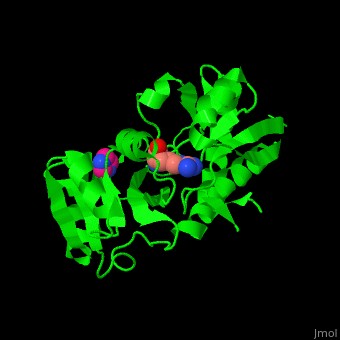ABC transporter
From Proteopedia
(Difference between revisions)
| Line 1: | Line 1: | ||
<StructureSection load='1l7v' size='400' side='right' scene='ABC_transporter/Cv/1' caption='Se-Met B12 Bacterial ABC Transporter complex with cyclo-tetrametavanadate, [[1l7v]]. Permease protein in green and grey, ATP-binding protein in yellow and pink.'> | <StructureSection load='1l7v' size='400' side='right' scene='ABC_transporter/Cv/1' caption='Se-Met B12 Bacterial ABC Transporter complex with cyclo-tetrametavanadate, [[1l7v]]. Permease protein in green and grey, ATP-binding protein in yellow and pink.'> | ||
| - | '''A'''TP '''B'''inding '''C'''assette (ABC) '''[[Transporters]]''' are ATP-dependent membrane proteins critical for most aspects of cell physiology, including the uptake of nutrients (importers) and elimination of waste products and energy generation (exporters) which are predominantly expressed in excretory organs, such as the liver, intestine, blood-brain barrier, blood-testes barrier, placenta, and kidney<ref name="Kidney"/><ref name="FourDomainsABCT"/>. There are many ABC Transporters in organisms, for instance, there are 28 in yeast,58 in ''Caenorhabditis'', 51 in ''Drosophila'',129 in ''Arabadopsis'',and the 69 ABC transporters in ''E. coli'' account for almost 5% of its genomic coding capacity<ref name="EColi"/>. ABC transporter protein translocates substrates across membranes. It contains a Solute Binding Domain (SBD). CFTR (Cystic Fibrosis Transmembrane Regulator) translocates chloride and thiocyanate. It contains a nucleotide binding domain (NBD). Mutations in CFTR lead to Cystic Fibrosis. In humans the ABC transporters are classified into subfamilies, i.e. ABCB6 is ABC subfamily B member 6 | + | '''A'''TP '''B'''inding '''C'''assette (ABC) '''[[Transporters]]''' are ATP-dependent membrane proteins critical for most aspects of cell physiology, including the uptake of nutrients (importers) and elimination of waste products and energy generation (exporters) which are predominantly expressed in excretory organs, such as the liver, intestine, blood-brain barrier, blood-testes barrier, placenta, and kidney<ref name="Kidney"/><ref name="FourDomainsABCT"/>. There are many ABC Transporters in organisms, for instance, there are 28 in yeast,58 in ''Caenorhabditis'', 51 in ''Drosophila'',129 in ''Arabadopsis'',and the 69 ABC transporters in ''E. coli'' account for almost 5% of its genomic coding capacity<ref name="EColi"/>. ABC transporter protein translocates substrates across membranes. It contains a Solute Binding Domain (SBD). CFTR (Cystic Fibrosis Transmembrane Regulator) translocates chloride and thiocyanate. It contains a nucleotide binding domain (NBD). Mutations in CFTR lead to Cystic Fibrosis. In humans the ABC transporters are classified into subfamilies, i.e. ABCB6 is ABC subfamily B member 6. |
== Function == | == Function == | ||
Revision as of 10:42, 21 October 2015
| |||||||||||
3D Structures of ABC transporter
Updated on 21-October-2015
References
- ↑ 1.0 1.1 Huls et al. The Role of ATP Binding Cassette Transporters in Tissue Defense and Organ Regeneration. Journal of Pharmacology and Experimental Therapeutics, 2008; 328 (1)
- ↑ 2.0 2.1 2.2 Garrett R, Grisham CM. Biochemistry. 2008. 1059 pages
- ↑ 3.0 3.1 Linton KJ, Higgins CF. The Escherichia coli ATP-binding cassette (ABC) proteins. Mol Microbiol 28: 5–13, 1998
- ↑ 4.0 4.1 4.2 Linton KJ. Structure and Function of ABC Transporters. Physiology 22: 122-130, 2007; doi:10.1152/physiol.00046.2006
- ↑ 5.0 5.1 Borths EL. Structural and biochemical characterization of the vitamin B12 ABC transporter, BtuCD-F. Dissertation (Ph.D.), California Institute of Technology. 2005
Proteopedia Page Contributors and Editors (what is this?)
Michal Harel, Alexander Berchansky, Joel L. Sussman, Zina Saadi

